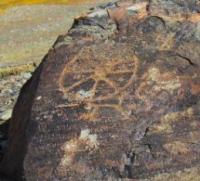Вы здесь
Petroglyphs of Mosrif gorge.

Welcome to Petroglyphs of Tajikistan.
“Does progress mean that we dissolve our ancient myths? If we forget our legends, I fear that we shall close an important door to the imagination”
James Christensen.
Historic Petroglyph of Tajikistan.
A significant accumulation of petroglyphs was found on gorge Mosrif, on the right tributary of the Shing River, the village council of Shing in the Panjakent district of Sughd region. A large concentration of petroglyphs was discovered at Mosrif Sai, the right tributary of the Shing River, Shing village council.
The concentration of petroglyphs includes ten sites on the right bank of the Mosrif gorge. Level of Study Dalskiy A.N. discovered and examined the concentration of petroglyphs in 1947 (Dalsky 1949, 1950).
The total quantity of images has not been estimated.
Four mountain goats with large horns bent backwards, two humans and a dog are engraved on the smooth surface of a rock 4km from the junction of the gorge with the Shing River. Isolated images are found on rocks farther on.
At a distance of 5.5km from the mouth of the sai at the exit from a narrow gorge, there are odd tape-shaped lines and outlines of two wild goats on a rock on the right bank. There are also a sign and coarse carved images of goats and camels.
The largest concentrations of petroglyphs was registered 1.5km higher than the village of Gizhdarva at an altitude of 2,200m. A layer of dark-gray dolomitic limestone hides a cave 3m above ground, with a large group of engravings in a sort of 12m x 1.4m frieze with more than 100 images of various sizes that sometimes join in small panels but are more often isolated.
Wild goats prevail, camels and humans are less frequent. That special group includes signs and images of an open human palm. The state of conservation of the drawings differs and many of them are barely visible.
Their patina varies and some drawings can only be seen close-up. Some large images of Markhoor goats are 20 - 37cm long and 42 - 52cm high. The largest palm images are 48 х 69cm and more than 1.5m. Most images are carved in a linear or skeletal style.
Animal bodies are depicted with one single line or not outlined at all in other cases. Mountain goats, in a majority, have disproportionately long legs and horns, and a hooked tail. Humans are also carved in a linear style, with their hands open (in one case fingers are shown), some of them resembling cross-like figures.
In addition to isolated animal figures and human images, there are also panels. Some animals are depicted with fetlocks, there are scenes of animals fighting, of a male and a female, and groups of mountain goats.
Excellent images of large and small mountain goats are carved side by side. There also are seven and eight point stars, an image of an open palm, and a house plan on two limestone boulders opposite and 20m away from the frieze.
According to the published photos, the images have been pecked with a stone and less frequently with a metallic implement. Dating Most of the drawings are dated to Modernity (20th Century); isolated images may be older, but their age has not been determined exactly.
Authority:
Bobomullo S. Bobomulloev.
Photos by
Surat Toymasov.







